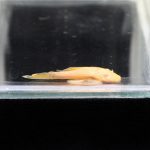
If you’re considering adding one or more new species to your aquarium, you’ll probably be asking what types of freshwater aquarium catfish food are best. There are many options, and these can range from gold nugget pleco to Bristlenose pleco to Cory. However, the most important thing to remember when buying catfish food for your freshwater aquarium is to keep them healthy. If they’re not eating enough food, they’ll suffer and will need to be moved to another tank or to the market.
Contents
Gold Nugget Pleco
This popular freshwater aquarium catfish can be identified by its distinctive yellow-polka dotted body. It has a dark green to black body with yellow dots evenly spaced across it. Its fins are also framed by yellow borders. The Gold Nugget has a large suckermouth and a broad dorsal fin. Gold Nugget Plecos are a great choice for any new aquarium.
The primary food source for Gold Nugget Pleco is algae and various organic matter in the substrate. However, many owners supplement with sinking pellets to meet their fish’s dietary needs. You may also consider adding bloodworms or tubifex every once in a while for enrichment purposes. Tubifex and bloodworms are also excellent foods for Gold Nugget Pleco.
Bristlenose Pleco
While many pet owners choose to keep one or more Bristlenose Pleco in their aquariums, it’s best to have a specific diet if you intend to keep a thriving population. This fish can grow to massive sizes if kept in a 40-litre tank, but they can be aggressive if kept in close quarters. In order to prevent aggression, use a high-quality catfish food specifically formulated for these fish.
Freshwater aquarium catfish food for Bristletnose plecos should contain a minimum of 15 percent protein. Meaty food is ideal for Bristlenose Plecos, and many pet stores carry prepared varieties of this food in the form of wafers, pellets, or flakes. These foods are ideal staples, as they sink, which is very important for bottom feeders.
Clown Pleco
If you’re interested in breeding Clown Pleco, you need to understand their needs and requirements. Clown Plecos will need a breeding tank with similar water parameters to a standard aquarium and hiding areas. A wooden cave is a common breeding tactic. You can provide live plants and algae wafers to supplement their diet. It is also recommended to feed them plant-based food daily. These catfish love algae, so it is important to provide them with a diet of plant-based food.
When introducing Clown Pleco to your freshwater aquarium, start by raising the pH level. Then, add a protein-rich food to stimulate breeding. Male Clown Plecos will guard their eggs until they hatch, so you will need to separate the hatchlings from the adults. Clown Plecos prefer spending time at the bottom of the tank. They’re sensitive to pH and can eat aquatic plants.
Cory
The best freshwater aquarium catfish food for Cory is one that is specifically designed for the species. Corys are generally easy to care for, and they get along with a variety of other fish. They also help to maintain the ecosystem of the aquarium. To ensure their long-term health, you should buy high-quality foods that contain the right ingredients for their specific needs. Listed below are some helpful tips.
As for diet, the Cory can eat flaked foods made of fish meal, squid meal, shrimp pellets, earthworms, and algae wafers. Flaked foods are great sources of protein, vitamins, and minerals. You can also feed your Cory flakes or bloodworms on occasion. If you want to supplement the Cory’s diet with live foods, you should offer them a variety of these once a day. They’ll occasionally eat the small eggs of other fish as a treat, so make sure to rotate the types of food you give them.
Asian Stone catfish
If you are considering adding an Asian Stone catfish to your freshwater aquarium, you should know about their unique characteristics. This bottom-dwelling peacenik is also known as an anchor catfish and is red, brown, or gray in color. They like a pH balance between 5.6 and 7.6. Because they are so small, Asian Stone catfish are best kept in groups of three or four.
The first thing you should know about these fish is that they like small, peaceful groups. You can house them in a 10-gallon tank, which is perfect for this species. They prefer a tank that has a low water level and a soft sandy substrate. While Asian Stone catfish can grow up to be very hefty, they don’t tend to be aggressive toward other fish. They are mellow and peaceful and will tolerate other fish in the aquarium just fine.
Chinese Algae Eater
If you’re looking for a new fish to add to your aquarium, consider getting a Chinese algae eater. This species is known to be a prolific eater of aquarium algae. Chinese algae eaters prefer a tank with a pH of 5.5 to 8.0, a hardness of eight to ten KH, and no nitrates or nitrites. Performing weekly water changes is important for this species, as well as a regular diet of live food.
The Chinese Algae Eater is hard to breed at home, and there are few reports of successful home-spawning. Regardless of your location, Chinese algae eaters can develop common health problems like ich. This disease is caused by poor water conditions and stress. Chinese algae eaters are also susceptible to bloat, which can cause serious digestive problems. If you notice signs of these problems in your fish, they can be easily treated with freshwater aquarium salt or a commercial antibacterial solution.




